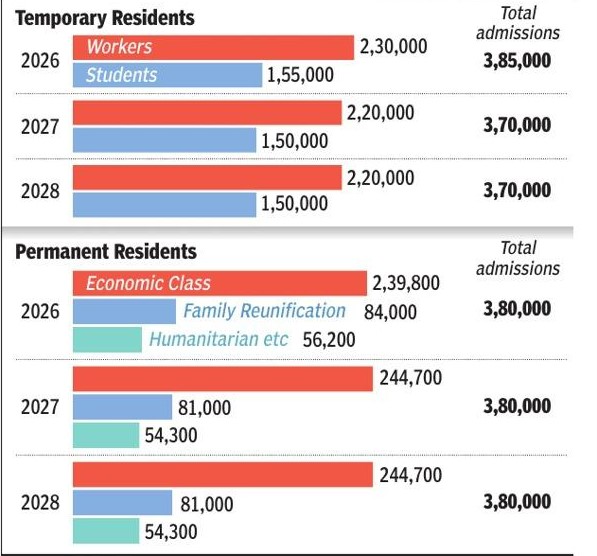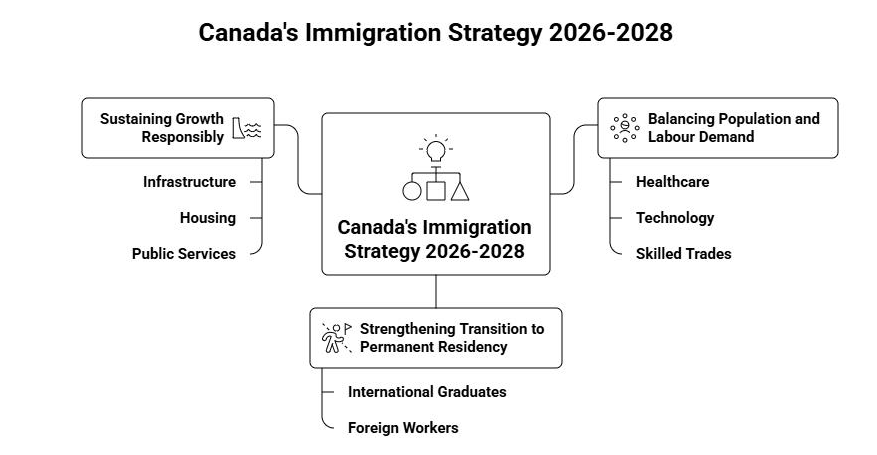Posted on November 06 2025
Breaking News! Canada targets 2 million TRs and PRs under 2026–2028 Immigration Levels Plan!
By , Editor
Updated November 06 2025
Highlights: Canada’s 2026–2028 Immigration Levels Plan to Grant 2 Million TRs & PRs
Canada has unveiled its new 2026–2028 Immigration Levels Plan, inviting nearly 2 million temporary residents and permanent residents over the next three years.
- The country will admit around 380,000 new permanent residents annually, maintaining steady targets to support labour market and economic growth.
- For the first time, Canada introduces formal targets for temporary residents, covering international students and work-permit holders.
- Over 30,000 current work-permit holders are set to gain PR under expanded in-Canada transition pathways.
- The plan aims to reduce the temporary-resident share to about 5% of the population, balancing growth with sustainability.
*Want to apply for Canada PR? Let Y-Axis guide you with the process.
Canada’s 2026–2028 Immigration Plan Opens New Doors to 2 Million People
Canada’s latest immigration plan reinforces its position as a top destination for Indian professionals, students, and families. With stable PR targets and expanded in-Canada pathways, the plan creates more predictable and inclusive opportunities for Indians aiming to settle permanently.

How the Plan Benefits Indian Applicants:
- More PR opportunities: Canada will grant 1.5 million new PRs by 2028, with strong demand for skilled workers — a key advantage for Indian professionals.
- Better transition routes: Indian students and work-permit holders already in Canada will find smoother pathways to permanent residency.
- High demand for skills: Occupations in IT, healthcare, engineering, and finance continue to be priority areas for Canada’s economic immigration streams.
- Family reunification stays strong: Over 80,000 family visas per year ensure Indian families can reunite and settle together.
- Stable and transparent targets: Consistent immigration levels help Indian aspirants plan applications confidently over the next three years.
*Willing to apply for a Canada Visa? Y-Axis is here to assist you in all the paths.
Canada’s Next Big Move: 1.5 Million PRs Planned Under 2026–2028 Immigration Strategy
Canada has officially released its Immigration Levels Plan for 2026–2028, outlining how many newcomers the country will welcome over the next three years and how it plans to balance population growth, economic needs, and sustainability.
According to the latest announcement by Immigration, Refugees and Citizenship Canada (IRCC), the country will maintain its permanent resident (PR) targets at current levels, aiming to admit roughly 380,000 new PRs each year between 2026 and 2028. In total, this represents 1.5 million new permanent residents over the three-year period.
Also, read…
Canada PM Mark Carney announces new immigration plan to attract skilled foreign workers. Apply now!
Unlike previous plans that focused only on permanent migration, the 2026–2028 plan introduces a more comprehensive immigration framework, covering both permanent and temporary residents. For the first time, IRCC has also included formal targets for temporary residents such as international students and work-permit holders, to manage Canada’s growing non-permanent population.
The plan focuses on three major goals:
- Balancing population and labour demand: Ensuring immigration supports workforce needs, especially in healthcare, technology, and skilled trades.
- Strengthening the transition from temporary to permanent residency: Opening more pathways for international graduates and foreign workers already contributing to the Canadian economy.
- Sustaining growth responsibly: Keeping temporary residents at around 5% of the population so infrastructure, housing, and public services can meet demand.

IRCC’s strategy reflects a “stabilize and strengthen” approach, maintaining robust immigration while preventing the temporary-resident population from rising too sharply.
*Want to migrate to Canada? Sign up with Y-Axis for end-to-end support with the process.
IRCC Announces Immigration Targets for 2026–2028
The Government of Canada has outlined its Immigration Levels Plan for 2026–2028, setting clear targets for both permanent and temporary residents. The plan reflects a stable approach to long-term immigration, maintaining total permanent resident admissions at 380,000 per year, while managing temporary resident numbers for sustainability.
The Economic Class continues to dominate the permanent resident intake, followed by Family Reunification and Humanitarian categories. For temporary residents, the government has projected steady numbers for both workers and students, with a total of 370,000–385,000 admissions annually.
This balanced strategy aims to meet Canada’s labour market needs, support economic recovery, and ensure responsible population growth.
Immigration Levels Plan 2026–2028
| Immigration Levels Plan 2026–2028 | ||
|---|---|---|
| Category | Year | No. of Residents |
| Temporary Residents | 2026 | 3,85,000 |
| Temporary Residents | 2027 | 3,70,000 |
| Temporary Residents | 2028 | 3,70,000 |
| Permanent Residents | 2026 | 3,80,000 |
| Permanent Residents | 2027 | 3,80,000 |
| Permanent Residents | 2028 | 3,80,000 |
| Total | 22,65,000 | |
*Are you looking for step-by-step assistance with Canadian immigration? Contact Y-Axis, the world’s No. 1 overseas immigration consultancy!
For recent Canadian immigration updates, check out Y-Axis Canada Immigration News!
FAQs
What is Canada’s Immigration Levels Plan 2026–2028?
Canada’s Immigration Levels Plan 2026–2028 is the government’s official roadmap outlining how many new permanent and temporary residents will be welcomed each year. It sets annual admission targets across key categories — Economic, Family, Refugee, and Humanitarian. The plan aims to maintain stability, strengthen in-Canada transitions, and ensure sustainable population growth. For the 2026–2028 period, Canada will continue to welcome about 380,000 permanent residents annually, focusing on skilled workers, family reunification, and humanitarian commitments. It also introduces formal targets for temporary residents, such as international students and workers.
How many permanent residents will Canada admit under the 2026–2028 Immigration Plan?
Under the 2026–2028 Immigration Levels Plan, Canada will maintain steady permanent resident admissions at approximately 380,000 per year. This represents about 1.5 million new permanent residents over three years. The government aims to balance immigration with labour market needs and housing capacity. Most of these admissions will fall under the Economic Class, which includes Express Entry and Provincial Nominee Programs. The plan continues Canada’s strategy of stable, predictable immigration to support economic growth, regional development, and family reunification, ensuring newcomers can successfully integrate into Canadian society.
What are the main immigration categories included in Canada’s 2026–2028 plan?
The 2026–2028 Immigration Levels Plan includes four main categories: Economic, Family, Refugee, and Humanitarian. The Economic Class—which includes Express Entry, PNPs, and the Canadian Experience Class—accounts for about 60% of total admissions. The Family Class, including spousal and parental sponsorships, makes up around 24%. Refugees and Protected Persons represent about 14%, while Humanitarian and Other programs account for roughly 2%. This distribution highlights Canada’s ongoing commitment to skilled migration, family unity, and global humanitarian responsibility, ensuring a balanced approach to both economic and social goals.
How will the new plan benefit Indian professionals and students?
The 2026–2028 plan is especially beneficial for Indians, who make up the largest share of Canada’s immigrants. Skilled professionals from India can access increased opportunities through programs such as Express Entry, Provincial Nominee Programs, and work-to-PR pathways. The plan also formalizes temporary resident targets, helping Indian students and work permit holders in Canada transition more easily to permanent residency. Family sponsorship numbers remain strong, allowing more families to reunite. Overall, the plan provides Indians with more predictable, transparent, and long-term pathways to settle and grow in Canada.
Are there new targets for temporary residents like students and work permit holders?
Yes. For the first time, Canada’s 2026–2028 Immigration Levels Plan introduces formal targets for temporary residents, which include international students and work permit holders. The government aims to maintain a responsible balance between permanent and temporary populations. Temporary resident admissions are projected at around 370,000–385,000 per year. Canada also plans to reduce the share of temporary residents to approximately 5% of the total population by 2026. This ensures that international students and workers continue contributing to the economy while maintaining manageable levels of temporary migration.
Which immigration programs fall under the Economic Class in Canada’s 2026–2028 plan?
The Economic Class, representing about 60% of total admissions, includes the Express Entry system, Provincial Nominee Programs (PNPs), and Canadian Experience Class (CEC). Other programs like the Atlantic Immigration Program, Rural and Northern Immigration Pilot, and Agri-Food Pilot also fall within this category. These programs are designed to attract skilled professionals who can fill labour shortages in sectors such as IT, healthcare, construction, and engineering. The Economic Class remains the cornerstone of Canada’s immigration policy, aligning with the country’s goal to strengthen its workforce and support economic growth.
How many work permit holders are expected to gain PR under the new immigration plan?
Over 30,000 work permit holders are expected to transition to permanent residency under the 2026–2028 Immigration Levels Plan. This shift is part of Canada’s broader strategy to retain skilled temporary workers already contributing to its economy. Work permit holders who gain Canadian work experience are prioritized under programs like the Canadian Experience Class and certain Provincial Nominee Program streams. This approach helps address labour market needs and ensures that temporary residents who have successfully integrated into Canada’s workforce have a clear pathway to permanent settlement.
What is the target number of family reunification visas under the 2026–2028 plan?
Canada’s Immigration Levels Plan 2026–2028 maintains strong targets for family reunification, with around 81,000–84,000 admissions per year under the Family Class. This includes spousal, partner, dependent, parent, and grandparent sponsorships. The goal is to ensure families can reunite and build stable lives in Canada. The government recognizes family unity as a key component of successful integration and community building. By maintaining these levels, Canada continues to uphold its humanitarian and family values alongside its economic immigration objectives.
How can Indians increase their chances of getting Canada PR under this plan?
Indian applicants can boost their chances by aligning their profiles with Canada’s immigration priorities. Improving CRS scores through higher English or French test results, gaining additional work experience, or securing a provincial nomination can significantly enhance eligibility. Those already in Canada on study or work permits can take advantage of in-Canada transition pathways. Staying updated on Express Entry draws and new PNP streams also helps. With strong demand for skilled professionals, Indian applicants who prepare strategically and meet program requirements stand excellent chances of securing Canada PR.
When will Canada’s next Immigration Levels Plan be announced?
Canada updates its Immigration Levels Plan annually, usually in October or November. Each plan provides a three-year projection outlining immigration targets by category and program. The next plan, covering 2029–2031, is expected to be announced in late 2028. These annual updates allow the government to adjust admission levels based on economic needs, population goals, and global trends. Applicants are advised to monitor official IRCC announcements regularly to stay informed about changes in quotas, eligibility requirements, and application timelines.
Tags:
Canada immigration
Migrate to Canada
Canada visas
Canada immigration news
Canada immigration levels plan
Immigration Levels Plan 2026-2028
Canada PR
Permanent residency in Canada
PR in Canada
PR Visa
Canada PR visa
Temporary residents in Canada
Share
Options for you by Y-Axis
Get it on your mobile
Get News alerts
Contact Y-Axis

